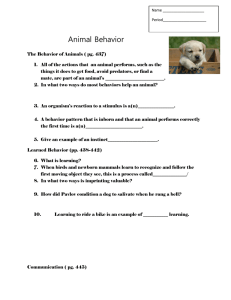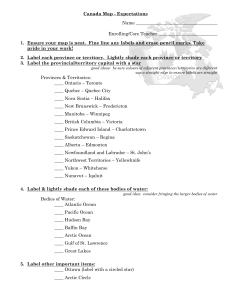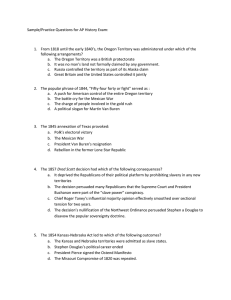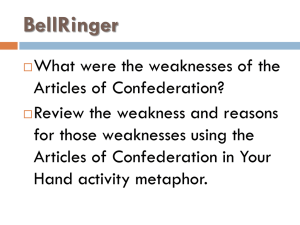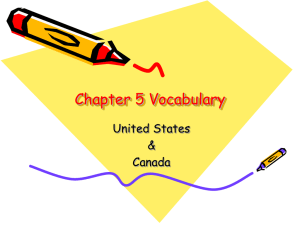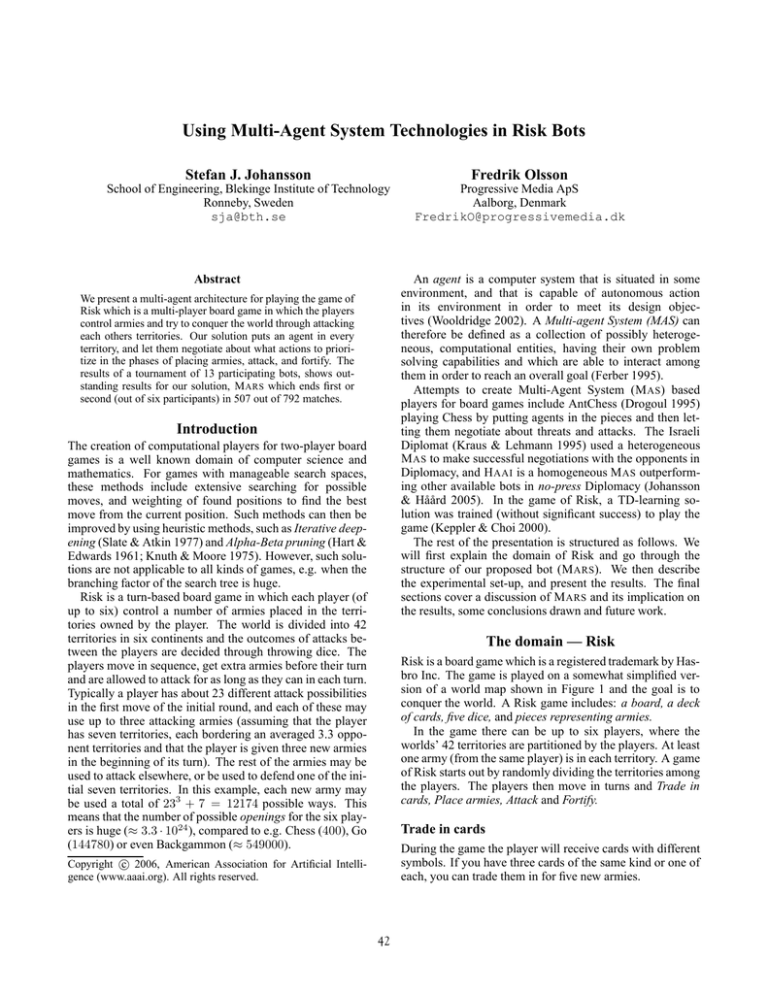
Using Multi-Agent System Technologies in Risk Bots
Stefan J. Johansson
Fredrik Olsson
School of Engineering, Blekinge Institute of Technology
Ronneby, Sweden
sja@bth.se
Progressive Media ApS
Aalborg, Denmark
FredrikO@progressivemedia.dk
An agent is a computer system that is situated in some
environment, and that is capable of autonomous action
in its environment in order to meet its design objectives (Wooldridge 2002). A Multi-agent System (MAS) can
therefore be defined as a collection of possibly heterogeneous, computational entities, having their own problem
solving capabilities and which are able to interact among
them in order to reach an overall goal (Ferber 1995).
Attempts to create Multi-Agent System (M AS) based
players for board games include AntChess (Drogoul 1995)
playing Chess by putting agents in the pieces and then letting them negotiate about threats and attacks. The Israeli
Diplomat (Kraus & Lehmann 1995) used a heterogeneous
M AS to make successful negotiations with the opponents in
Diplomacy, and H AAI is a homogeneous M AS outperforming other available bots in no-press Diplomacy (Johansson
& Håård 2005). In the game of Risk, a TD-learning solution was trained (without significant success) to play the
game (Keppler & Choi 2000).
The rest of the presentation is structured as follows. We
will first explain the domain of Risk and go through the
structure of our proposed bot (M ARS). We then describe
the experimental set-up, and present the results. The final
sections cover a discussion of M ARS and its implication on
the results, some conclusions drawn and future work.
Abstract
We present a multi-agent architecture for playing the game of
Risk which is a multi-player board game in which the players
control armies and try to conquer the world through attacking
each others territories. Our solution puts an agent in every
territory, and let them negotiate about what actions to prioritize in the phases of placing armies, attack, and fortify. The
results of a tournament of 13 participating bots, shows outstanding results for our solution, M ARS which ends first or
second (out of six participants) in 507 out of 792 matches.
Introduction
The creation of computational players for two-player board
games is a well known domain of computer science and
mathematics. For games with manageable search spaces,
these methods include extensive searching for possible
moves, and weighting of found positions to find the best
move from the current position. Such methods can then be
improved by using heuristic methods, such as Iterative deepening (Slate & Atkin 1977) and Alpha-Beta pruning (Hart &
Edwards 1961; Knuth & Moore 1975). However, such solutions are not applicable to all kinds of games, e.g. when the
branching factor of the search tree is huge.
Risk is a turn-based board game in which each player (of
up to six) control a number of armies placed in the territories owned by the player. The world is divided into 42
territories in six continents and the outcomes of attacks between the players are decided through throwing dice. The
players move in sequence, get extra armies before their turn
and are allowed to attack for as long as they can in each turn.
Typically a player has about 23 different attack possibilities
in the first move of the initial round, and each of these may
use up to three attacking armies (assuming that the player
has seven territories, each bordering an averaged 3.3 opponent territories and that the player is given three new armies
in the beginning of its turn). The rest of the armies may be
used to attack elsewhere, or be used to defend one of the initial seven territories. In this example, each new army may
be used a total of 233 + 7 = 12174 possible ways. This
means that the number of possible openings for the six players is huge (≈ 3.3 · 1024 ), compared to e.g. Chess (400), Go
(144780) or even Backgammon (≈ 549000).
The domain — Risk
Risk is a board game which is a registered trademark by Hasbro Inc. The game is played on a somewhat simplified version of a world map shown in Figure 1 and the goal is to
conquer the world. A Risk game includes: a board, a deck
of cards, five dice, and pieces representing armies.
In the game there can be up to six players, where the
worlds’ 42 territories are partitioned by the players. At least
one army (from the same player) is in each territory. A game
of Risk starts out by randomly dividing the territories among
the players. The players then move in turns and Trade in
cards, Place armies, Attack and Fortify.
Trade in cards
During the game the player will receive cards with different
symbols. If you have three cards of the same kind or one of
each, you can trade them in for five new armies.
c 2006, American Association for Artificial IntelliCopyright gence (www.aaai.org). All rights reserved.
42
To avoid that a single match of Risk takes too long we
have set a limit of 100 rounds. If the game has not terminated
by then, it is considered to have reached a stalemate and the
game is terminated by the game server.
Multi-Agent Risk System
When designing a system like this, there are three main foci:
Agent distribution: How many agents and what do they control? Agent communication: How will the agents communicate? Agent negotiation: How will the agents negotiate?
Agent Distribution
There are two main ways in which a system may be structured. A task-oriented agent system has one agent for each
relevant task, e.g. defence, card handling, or conquering
North America. These systems are heterogeneous in the
sense that all the agents are basically different.
An entity-oriented agent system has one agent per relevant entity in the domain. Here the agents are homogeneous.
They are all built in the same way and may represent continents, territories, or even individual armies.
We have chosen to let each territory (own and opponents’)
be represented by an agent. This gives us a good balance
between the complexities of the agents and the architecture.
In addition we have one agent that takes care of the cards
and an additional agent that communicates with the game
server and facilitates the auctions.
Figure 1: World map used in Risk.
Place armies
At the beginning of a placement phase the player is given a
number of armies, a, based on the number of territories n,
possibly card bonus b, and owned continents C ⊆ U :
X
n
a = max(3, d e) + b +
dc
(1)
3
c∈C
The continent bonus, dc , is 7 for Asia, 5 for both Europe and
North America, 3 for Africa, and 2 for both South America
and Australia. The armies must now all be placed in at least
one of the territories owned by the player.
Attack
Agent Communication
Once a player has placed all armies the attack phase is entered. In this phase the player may, from any territory owned
by the player which has more than one army, attack a neighbouring territory owned by an opponent. The outcome of
an attack is determined by the dice. The attacker chooses
the number of armies to attack with and rolls that number of
dice (up to three). The defender rolls a die for each of the
armies in the defending territory, (up to two). The highest
attacking die is matched with the highest defending die and
the one with the lowest value looses an army. In case of a
tie the attacker looses. If the defender rolled two dice, the
process is repeated with the second highest dice.
If the defender runs out of armies the attacker takes over
that territory and must decide on the number of armies to
bring in into the new territory. This number must be at least
the number of dice rolled by the attacker in the last attack. If
a defender lose its last territory, the player has lost the game.
Since standard Risk bots are monolithic, it is safe to assume that any game server found will need to communicate through a single point. This can be solved by introducing a Mediator agent (Hayden, Carrick, & Yang 1999;
Shu & Norrie 1999). The Mediator will create the territory agents and handle all communication between them.
This means that the territory agents need not know about the
other territory agents and have one single point for communication. The Mediator is also a layer of abstraction for the
game server, letting the game server see M ARS as a single
bot instead of a whole system of agents.
Agent Negotiation
The typical case of negotiation that will take place in M ARS
will be to settle disputes such as: Who needs this army the
most? and What territories should we attack?
We have solved these problems through using a first price
sealed bid auction mechanism (Wooldridge 2002). This will
work in such a way that the mediator agent will put out a request for bids on the available armies. Upon receiving such
a request every territory agent will reply by sending a bid of
how useful the extra armies will be for the agent. If the bid
wins the auction, the agent will receive the new armies.
Fortify
When a player has finished its attack phase, it may move
armies within its territory clusters. Out of all variants of this
rule, we follow the common house rule, listed in the Risk
FAQ (Lyne et al. 2005). It states that during the fortification
phase any army may move to any neighbouring territory, but
it may only move a total of one step during a turn. As before,
no territory may have zero armies at the end of the phase.
Architecture
Limitations of this study
M ARS has three different types of agents, as can be seen
in Figure 2 (a closer description of the general architecture
used can be found in (Johansson 2006)).
Players may not cooperate e.g. by signal their intentions in
such a way that it affects the actions of the other players.
43
MARS
Game server
Mediator Agent
Territory Agent
Card Agent
Vcb ∈ N
Voc ∈ {0, 1}
M ARS is a fairly parametrized system. In Tables 1–2 you
see the main parameters used, where Wp , Pdb and Pob are
the most important ones. Since Pdb and Pob are not independent, given a value of one of them, we may search for an
optimal value of the other. In our experiment, we searched
the 2D space of Wp and Pob for an optimal combination using narrowing techniques. The less significant parameters,
(e.g. in Table 2) were set in more or less ad hoc ways.
170
Wp
0.7375
Wp1
Gl
0.25
5
1.2
-0.3
0.05
-0.03
0.5
20
4
Ven ∈ N
Venu ∈ N
Parameters
Pob
Cf n
Cen
Cf nu
Cenu
Ccb
Coc
Ceoc
Variable
Vb ∈ N
Vs ∈ N
Vnb ∈ N
Vsv ∈ Q
Vcp ∈ [0, 1]
Vf n ∈ N
Vf nu ∈ N
The Mediator agent receives the calls from the game
server about what phase the game is in and coordinates the
other agents’ activities in the phases. It requests bids from
the agents and then selects the winner, thereafter the actions
of the winning agent are sent to the game server to be performed in the actual game.
In every territory on the board there is a Territory agent.
On request for a bid, it will calculate a bid based on its current neighbourhood and send it back to the mediator.
The Card agent is quite simple. Its actions are based on a
cost and reward system optimizing the use of the cards.
Value
3.5
Value
70
Explanation
Bonus multiplier, used to adjust the static territory value
Value of having a friendly neighbour
Value of having an enemy neighbour
Value of each own neighbouring unit
Value of each neighbouring enemy unit
Bonus for bordering a continent
Bonus for owning a whole continent
Enemy owns the whole continent
Table 2: Territory specific M ARS parameters.
Figure 2: M ARS Architecture.
Param.
Pdb
Param.
Csv
Veoc ∈ {0, 1}
Explanation
The continent bonus value
The size of the continent
The number of borders to the continent
Vb /(Vs ∗ Vnb ) The static territory value
How much of this continent do we own
How many friendly neighbours
How many armies do the friendly
neighbours have
How many enemy neighbours
How many armies do the enemy neighbours have
How many continents does this territory
border
Do we own the whole continent except
this territory
Does an enemy own the continent
Table 3: The M ARS evaluation variables.
Using the values of Table 3, and the parameters from Table 2, the value of a territory Vc is defined as follows:
Explanation
Bonus multiplier, higher value makes
the bot more defensive.
Bonus multiplier, higher value makes
the bot more offensive.
The probability treshold for a win in order to attack.
The value of Wp before the first win.
Maximum path length.
Vc =Psv + Pf n + Pf nu + Pen + Penu + Pcb +
Vb ∗ (Vcp + Poc + Peoc ), where
(2)
Px = V x ∗ C x
(3)
Dice Odds
A large part of the odds calculations in Risk is based on dice.
With a battle is meant a single roll of one to three dice by
the attacker and one to two by the defender. This process
is often repeated when the defender and the attacker have
multiple armies.
By calculating the outcome of every possible dice combination, the odds in Table 4 are given.
Table 1: General M ARS parameters.
Territory Evaluation
Number of attacking dice:
Attacker wins:
1
Defender wins:
Attacker wins:
Defender wins:
2
One each:
Number of
defending
dice
In Risk, not all territories are the same. Some territories
might be very valuable to have, while others may not and
this varies over the game. The value of a territory consists
of two parts, — a static part and a dynamic part.
The static part is the same for all territories in the same
continent and is based on the continents bonus value Vb , its
size Vs and the number of borders Vnb . The dynamic part is
based on what the neighbourhood looks like. Factors affecting the territory value are presented in Table 3.
1
42%
58%
25%
75%
—
Table 4: Dice odds for battles
44
2
58%
42%
23%
45%
32%
3
66%
34%
37%
29%
34%
Name
M ARS
Bort
EvilP.
Boscoe
Yakool
Quo
Pixie
Shaft
Cluster
Nefar.
Comm.
Stinky
Angry
Actions
During each turn there are three phases which are described
here (we omit the more or less trivial card trading phase).
The mediator agent dispatches the phase information to the
relevant agents who in turn act on it.
Place armies The Mediator first sends out a message to
all agents in territories not owned by M ARS. These agents
will then tell all their neighbours about the value of owning
that specific territory and how many armies are defending
it. When an agent receives such a message from a neighbour it will append its values and send the message on. The
message will be discarded if the chain of values exceeds Gl .
When a territory that is owned by M ARS receives such a
list, it will store it in its goal list, containing all possible goals
achievable by a territory. In the second step, all own agents
calculate and submit both offensive and defensive bids for
zero to n armies. A bid for zero armies is included to get
bids for goals that require no extra armies since only the
goals that win a bidding will be pursued. Given that pi is
the probability to reach goal i,1 wi is the value, di is the expected probability of defending i (given the current neighbourhood), and v being the value of the current territory the
equations of the offensive and defensive bids are:
pi wi di i = 0,
n
(4)
bo = max pi wi di
i=0
i≥1
i
n
bd = max
i=0
(
v ∗ d(i+m)
v∗d(i+m)
i
i=0
i≥1
1st
338
206
205
184
135
177
118
117
100
84
16
7
6
2nd
169
47
56
52
57
103
153
370
137
115
278
139
17
3rd
60
130
105
142
118
102
102
157
165
128
199
204
89
4th
62
156
153
174
162
132
123
61
161
141
130
141
113
5th
69
149
138
157
167
134
139
36
118
168
85
147
207
6th
84
100
133
76
146
142
154
38
105
156
74
149
358
Sm
10
4
2
7
7
2
3
13
6
0
10
5
2
Table 5: The outcome of the tournament. Sm is the number
of stalemates.
For each seller in the list there will be an intra-cluster auction where the available armies are sold to the territories that
need them the most (within the cluster). Since each army
can move one step only, a transportation cost is included
and max-flow calculations (Edmonds & Karp 1972) are performed so that the move constraints are not violated.
Experimental Set-up
We evaluate our solution by letting it play against a number of other bots.2 There are several platforms available,
e.g. JavaRisk (Kirsch et al. 2005), JRisk (Kinlan 2005), and
Lux (SillySoft 2005). These have three, two and twelve bots
available respectively. Thus the choice fell upon Lux featuring the following bots: Angry, Communist, Stinky, Cluster, Pixie, Shaft, Yakool, Boscoe, Bort, EvilPixie, Quo which
are implemented by the developers of Lux (SillySoft 2005)
and Nefarious which is an independent implementation. The
bots are described in more detail by Olsson in (Olsson 2005).
The evaluation was performed through running a round
robin tournament with the thirteen available bots. We ran
one match with each six element subset of the thirteen
bots. The order of the bots was random, leaving 13
6 =1716
games, where each bot played 792 of them. The territories
were distributed randomly in the beginning of the game.
(5)
Once all this is done, the agent will take the maximum
value of bo and bd and submit it to the Mediator. The Mediator will go through all bids received and select the maximum bid as the winner. If this number is less than n the
process will be repeated with the remaining armies. For
more details about the dice probabilities of Risk, we refer
to Lemke (Lemke 1999).
Attack Once the attack phase has started the Mediator will
ask all eligible agents to submit bids for attacking. To be eligible an agent needs to be in a territory owned by M ARS,
have an enemy neighbour and have more than one army. The
agent with the highest success odds, (must be ≥ Wp ), will
get allowed to perform its attack. If the attacker wins the
conflict it will send the goal path to the conquered agent,
which will accept it as its own goal and the process is repeated until the odds are below Wp .
Results
The results are presented in terms of Wins and Runtime. The
experiment involved playing 1716 matches of which all but
23 ended with a winner before the 100:th turn.
M ARS won more matches (338) than any other bot, as can
be seen in Table 5 and Figure 3. When looking at both first
and second placements, M ARS finished top two in 507 out of
the total 792 played matches. This is almost as much as the
sum of the second and third placed bots Bort and EvilPixie
(514). Note that Shaft is the most runner-up (370).
Fortify The fortification phase starts out by the Mediator
retrieving a list of all owned clusters of connected territories
and their distribution of armies. The number of armies a
territory can spare for movements elsewhere depends on its
environment, how strong the enemies are, or if the territory
is a cluster, or a continent border. When this is done the
Mediator has a list of all possible sellers in the cluster.
2
Evaluating the solution against human players would lead to
problems of both slow evaluation and unfair competition (a common agreement among many human competitors in tournaments
open to bots is to terminate the bots first).
1
The value of Pi can be calculated through the probabilities
of reaching the goal territory through its shortest path, given the
number of armies M ARS and the opponent(s) have.
45
0
50
100
150
200
250
300
350
400
Mars
Bort
EvilPixie
Boscoe
Quo
Yakool
Pixie
Shaft
Cluster
Nefarious
Figure 4: The average runtime tturn (s).
Communist
Stinky
Angry
We ran a total of 1732 matches in the experiments equally
distributed over the circumstances. M ARS is doubtless the
most winning bot. When it comes to average placing, it is
still the better than Shaft with a probability of 71.7 per cent.
Qualitative Analysis We believe that there are several factors contributing to the good performance of M ARS, e.g.: In
each phase, all relevant territory agents cooperate to find a
good solution. The handling of uncertainties is essential.
M ARS uses the dice odds to calculate the expected outcome
of invading a territory several steps away (including the expected losses on the way). The use of the max-flow algorithm makes M ARS propagate as many armies as possible
through its territories in each fortification phase.
However, when calculating the mean placement of the
bots in the games, M ARS is not alone in the top (average
placed at 2.49). Shaft placed at an averaged 2.54 is close.
Shaft will try to take one of the smaller continents early but
if it is unlucky in the draw of the territories it will be ultra defensive, placing all armies in one territory and not attacking. Saving up for a explosive expansion halfway into
a game. Even if it succeds in capturing that first continent
it will be extremely defensive and only expand once it can
take a large amount of its surrounding territories. If it is successful in both capturing a continent early as well as in the
crucial explosive expansion mid-game, it has a good chance
of winning. In most of the matches however it will either
not be able or even try to capture a continent and never find
it advantageus to perform an explosive expansion, or it will
expand too late/early. These scenarious most likely result in
second and third place finishes.
When it comes to M ARS vs. Shaft, M ARS wins 155 (Shaft
37) of the 302 matches where they met. In the 132 matches
where they were the only bots left, M ARS won 118.
Relevance Risk holds a number of properties that it shares
with domains that are considered to be hard (such as robot
football), e.g. the number of possible future states (even a
few steps ahead) is too large to facilitate exhaustive search.
Moreover the environment is hostile, in the sense that several
actors try to gain from your loss and coordination of actions
is needed in order to succeed in performing certain tasks.
We argue that the domain has passed the level of toy prob-
Figure 3: Wins in the tournament.
Name
M ARS
Boscoe
EvilP.
Bort
Quo
Pixie
Yakool
Shaft
Cluster
Nefar.
Comm.
Stinky
Angry
W in%
42.7
23.2
25.9
26.0
22.3
14.9
17.0
14.8
12.6
10.6
2.0
1.1
1.0
tmatch
79.72
40.04
44.10
45.75
33.87
40.04
37.62
74.47
54.32
46.82
49.37
48.88
41.33
turns
match
32.0
27.1
25.1
25.5
21.6
29.9
22.7
34.5
25.4
18.7
29.1
24.0
14.7
tturn
2.49
1.48
1.76
1.79
1.57
1.34
1.66
2.16
2.14
2.51
1.70
2.04
2.82
W in%
tturn
17.1
15.7
14.7
14.5
14.2
11.1
10.3
6.86
5.90
4.22
1.18
0.54
0.36
Table 6: The win percentage, average runtimes (in seconds)
per match and per turn, and number of wins per hour of
processing time.
As shown in Table 6 and Figure 4, M ARS spend more
time (tmatch ) than any other bot per match. Shaft is second
and has the highest averaged turns per match. Angry spends
the most time per turn (tturn ), whereas Pixie is the fastest.
M ARS, despite being among the slowest bots, reaches the
first place when it comes to the number of wins per tturn .
Discussion
We focus our discussion on the validity of the results, the
reasons for them, and their relevance, especially to M AS.
Validity There are several platforms which host other
bots. The main reason for choosing Lux was the supply of
them. The platform itself did not give any specific advantages to M ARS. The quality of the implementation of the
opponent bots is of course an important aspect. From what
we have seen neither the platforms, nor other maps did offer
any evidently better bot than the best ones in our experiment.
46
Multi-Agent World, MAAMAW-93 (LNAI Volume 957), 13–
27. Springer-Verlag: Heidelberg, Germany.
Edmonds, J., and Karp, R. M. 1972. Theoretical improvements in the algorithmic efficiency for network flow problems. Journal of the ACM 19:248–264.
Ferber, J. 1995. Multi-Agent Systems, - An Introduction to
Distributed Artificial Intelligence. Addison W.
Hart, T., and Edwards, D. 1961. The Tree Prune (TP) algorithm. Technical report, Massachusetts Institute of Technology, Cambridge, Massachusetts. Artificial Intelligence
Project Memo 30.
Hayden, S.; Carrick, C.; and Yang, Q. 1999. Architectural
design patterns for multiagent coordination. In Proceedings of the International Conference on Agent Systems ’99.
Johansson, S., and Håård, F. 2005. Tactical coordination in
no-press diplomacy. In Proceedings of Autonomous Agents
and Multi-agent Systems (A AMAS).
Johansson, S. 2006. On using multi-agent systems in playing board games. In Proceedings Autonomous Agents and
Multi-agent Systems (A AMAS).
Keppler, D., and Choi, E. 2000. An intelligent agent for
risk. Technical Report CS 473, Computer Science Department, Cornell University.
Kinlan,
P.
2005.
Jrisk
v1.0.8.4.
http://sourceforge.net/projects/jrisk/ URL last visited
on 2006-01-24.
Kirsch, S.; Domsch, C.; Engberg, D.; and Krug, S. 2005.
Javarisk v2.0.93. http://sourceforge.net/projects/javarisk/
URL last visited on 2006-01-24.
Knuth, D., and Moore, R. 1975. An analysis of alpha-betapruning. Artificial Intelligence 6(4):293–326.
Kraus, S., and Lehmann, D. 1995. Designing and building
a negotiating automated agent. Computational Intelligence
11(1):132–171.
Lemke, K.
1999.
Risk board game dice odds.
http://www.plainsboro.com/∼lemke/risk/ URL last visited
on 2006-01-24.
Lyne, O.; Atkinson, L.; George, P.; and Woods,
D. 2005. Risk - frequently asked questions v5.61.
http://www.kent.ac.uk/IMS/personal/odl/riskfaq.htm URL
last visited on 2006-01-24.
Olsson, F. 2005. A multi-agent system for playing the
board game risk. Master’s thesis, Blekinge Institute of
Technology.
Shu, S., and Norrie, D. 1999. Patterns for adaptive multiagent systems in intelligent manufacturing. In Proceedings
of the 2nd International Workshop on Intelligent Manufacturing Systems, 67–74.
SillySoft. 2005. Lux v4.3. http://sillysoft.net/ URL last
visited on 2006-01-24.
Slate, D., and Atkin, L. 1977. Chess 4.5 — the northwestern university Chess program. In Frey, P., ed., Chess skill
in Man and Machine. Berlin: Springer Verlag. 82–118.
Wooldridge, M. 2002. An introduction to Multi-Agent Systems. Wiley.
lems (even though there are of course more complex environments available) and that our multi-agent based solution
is novel in the domain of Risk.
Even though Risk shares several properties such as being
competitive, demanding supportive actions at piece level,
etc. with Chess and Diplomacy, there are great differences
too, e.g. the moves and the types of pieces used.
These differences make us to approach the problems from
different directions when designing agent systems able to
play the games. For instance, Chess allow (and force) us
to plan the support several steps ahead, something that is
very hard to do in both Risk and Diplomacy. Risk is a game
involving rolling dice. When calculating the possibility of
reaching a far goal within the turn of the bot, it has to keep
multiple models representing the possible outcomes of conquering intermediate territories on its way to the final goal.
This is in order to be able to cancel the final goal if the losses
on the way are too high.
Still there are parts of the systems that are common:
• A M AS is easily modularized in pieces or territories.
• The agents can, by negotiating with other agents within
reach of it, make common efforts to achieve (possibly
partly) common goals.
• The agent metaphor provides a good way of modelling
utilities at the individual agent level.
Is then M AS techniques the only way of implementing
M ARS? Although the functionality of M ARS could be implemented by means of traditional centralistic approaches,
we have found that agents are well suited to model the territories of Risk, both from the perspective of the current implementation, as well as of the possible extentions, e.g. by
letting the territories learn their own valuation functions.
Conclusions and Future Work
We have presented a novel distributed solution for a Risk
bot based on a multi-agent system. The agents of the system
represent the territories in the game. By using auctions for
negotiating about how to allocate the resources, our solution
showed good offensive performance reached at an acceptable amount of time in competition with available state-ofthe-art solutions. Future work will include:
• Calibrating all the parameters of the model in order to find
a near optimal settings for the Risk domain.
• Try our approach in domains, e.g. Settlers of Catan.
• Improve the theoretical understanding of the complexity
of M AS based bots.
• Adding a module of strategic analysis. At the moment,
Risk performs well without paying any attention to strategic matters. We believe that some strategic consideration
would improve M ARS even further.
References
Drogoul, A. 1995. When ants play chess (or can strategies
emerge from tactical behviours?). In Castelfranchi, C., and
Müller, J.-P., eds., From Reaction to Cognition — Fifth European Workshop on Modelling Autonomous Agents in a
47

